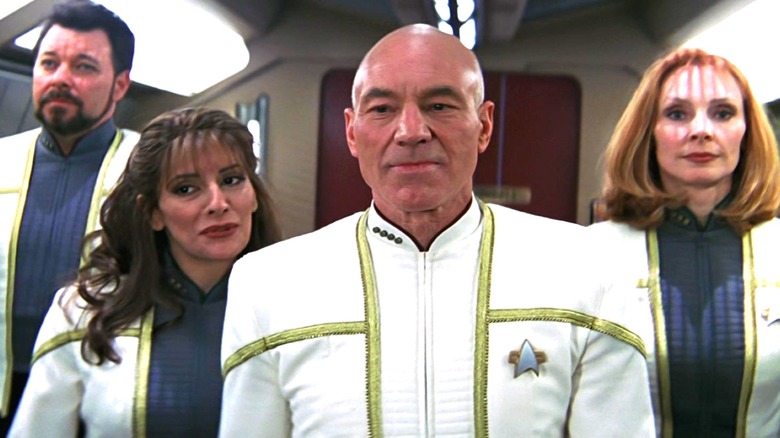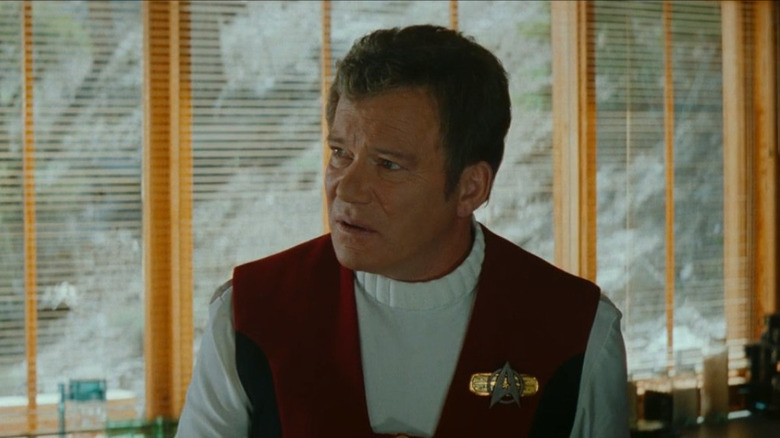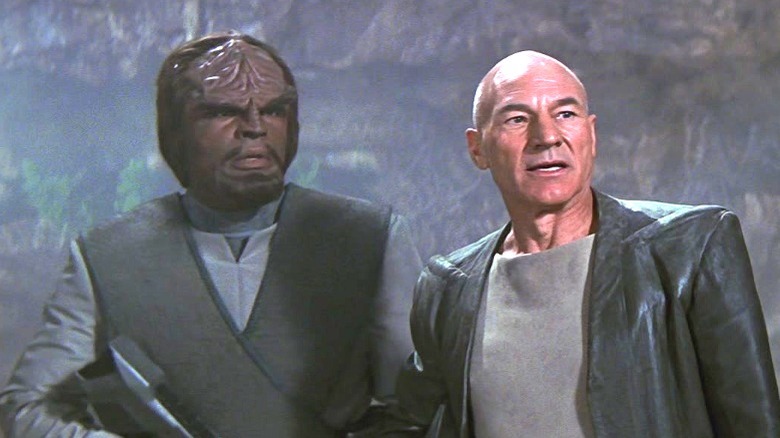The Star Trek: TNG Movie Timeline Explained
Six decades after Gene Roddenberry created "Star Trek," the final frontier has grown to include a whopping 13 movies and 12 TV shows. One of the most popular crews to helm the starship Enterprise debuts in the sequel to the original series, "Star Trek: The Next Generation," which takes place over 15 years in seven seasons and four films, from 2364 to 2379. While there is a little overlap in timelines with other series taking place at the same time, the films largely take place consecutively with no breaks.
The overall "Star Trek" timeline can get a little messy if you aren't familiar with how to watch them in order. Jean-Luc Picard takes over as captain of the starship Enterprise in 2364, 71 years after Kirk retires. He brings with him an all-new crew that includes William T. Riker (Jonathan Frakes), Geordi La Forge (LeVar Burton), Tasha Yar (Denise Crosby), Worf (Michael Dorn), and Data (Brent Spiner). The series runs for seven seasons and racks up 178 episodes dealing with many themes, including the dangers of technology and time, which contributes to the confusion of the timeline.
The crew constantly has to deal with threats due to time travel and other phenomena that mess with our concept of reality, changing pasts, futures, and presents. While many villains popped up throughout the seven seasons, by the time the films came along, fans had grown quite accustomed to the concepts. The films continued by seeing the crew deal with threats to time in different ways. Here is how each film fits within the timeline of "Star Trek."
Star Trek: Generations closes the book on the original crew
When "Star Trek: The Next Generation" began in 1987, the original series was still pumping out new films. As a matter of fact, "Star Trek V: The Final Frontier" and "Star Trek VI: The Undiscovered Country" both hit theaters during "The Next Generation" seasons. However, there is a seven-decade span between "The Undiscovered Country"'s setting in 2293 and the sequel series' debut in 2364.
In 1994, three years after "The Undiscovered Country," "The Next Generation" concluded its final season and got its first film. "Star Trek: Generations" officially passes the torch to the next crew on the big screen and closes out the storyline of the original crew. This allowed the studio to focus more on one cohesive storyline involving Picard and his crew.
Before the film's primary setting in 2371, it begins with a flashback to 2293 with a recently retired original crew attempting to save two El-Aurian ships caught in an energy ribbon. Kirk is believed to have been lost in space but is trapped inside a Nexus simulation. Tolian Soran (Malcolm McDowell) desperately tries to return to the Nexus, a realm of wish fulfillment existing outside of space and time. When Picard follows Soran into the Nexus and attempts to stop him, he teams up with the trapped Kirk. Of course, the captains are victorious, but Kirk is fatally wounded, and the film closes with a fitting end to Kirk and the original crew's story.
Star Trek: First Contact further convolutes time
One of the aspects of "The Next Generation" that makes the timeline a little confusing to those who aren't deep into the mythos and history is the fact that time is constantly in flux and usually under threat. The next film does so with an adversary attempting to alter the timeline long before Kirk and the Federation.
"Star Trek: First Contact" takes place in 2373, two years after the death of James T. Kirk, and was exciting for TV series fans due to the appearance of one of the most loved villains of the show, the Borg and its Collective. While they are a primary antagonist that continuously searches for the prospect of perfection, their goal in the second film in the "Next Generation" film series is to go back in time to stop humans from ever making contact with Vulcans, leading them on the path of joining the Federation of Planets. The crew battles the Borg with the USS Phoenix, and the film ends with the temptation of Data experiencing the sensation of touch. He ultimately gives it up so they can defeat the Borg and allow the Phoenix to complete its mission and make contact with the Vulcans.
The timeline being threatened by an adversary from the future is similar to the way the Kelvin timeline (the rebooted film franchise starring Chris Pine as James T. Kirk beginning in 2009) changed everything about "Star Trek," making us think that things were altered at some point, but luckily, the crew is able to restore everything to its rightful place. The next film also deals with time, albeit from a different angle.
Star Trek: Insurrection flips the concept on its head
Again waiting two years between storylines, "Star Trek: Insurrection" takes place in 2375. During this time, two other "Star Trek" series are happening. "Deep Space Nine" ends its series, which takes place alongside the last two seasons and first three films of "The Next Generation," and "Voyager" is halfway through its mission while this story takes place.
"Insurrection" sees Picard defy his chain of command and rebel against his orders to find his friend Data, who malfunctioned while undercover with the Son'a task force observing the Ba'ku, an alien species on the planet of the same name. When the crew arrives, they discover that the race is all but immortal thanks to the rings of the planet, which provide a healing property. The crew members all feel the effects, including Lt. Commander Geordi La Forge, who no longer needs his optical implants. Picard eventually discovers that his chain of command is conspiring with the Son'a to poison the Ba'ku people and steal the healing properties.
The concept of time is explored again in "Insurrection"; instead of manipulating time, the idea is flipped on its head, and our relationship with it is manipulated. Time is less critical if you can live forever, but the idea of living forever and facing your own mortality is faced in the final film of the "Next Generation" timeline, when the crew goes toe-to-toe with a part of Picard himself.
Star Trek: Nemesis explores mortality
Taking place four years after the previous installment, "Star Trek: Nemesis" occurs in the year 2379; it is, at least for a while, the end of the storyline of the crew of the Enterprise led by Picard. The film approaches the concept of time through the exploration of the captain's own mortality.
The new threat in "Nemesis" is Shinzon (Tom Hardy), a leader from the planet Remus who turns out to be a genetic clone of Picard. He spearheads a coup d'état to seize power on the planet Romulus and attempts to draw the Enterprise into a conflict between the Federation and Romulus, a conflict threatening to use the same radiation device that allowed Shinzon to seize power to destroy all life on Earth. The Enterprise discovers that Shinzon is dying, and when Picard rams the Enterprise into Shinzon's ship and renders them both crippled, the device is activated, assuring mutual destruction. Data transports onto the ship and places an emergency transportation device onto Picard, beaming him to safety before an explosion.
The timeline of "The Next Generation" can feel complicated due to its constant meddling with time, but to put it in the simplest terms, it spans 15 years, 2364 to 2379, overlapped by the original series, "Voyager," and "Deep Space Nine." However, it continues when "Star Trek: Picard" picks up Picard's story 20 years later with the return of Patrick Stewart as the beloved captain.




